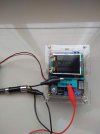Vineethkumar01
Well-Known Member
Here is a paper that i found which tells about audibility of differences between interconnect cables in an audio system.
This is a JAES journal paper. Ultimately they say it is not the frequency response or the impedance of the cable that causes audible differences but the noise pic up properties
Anyway interesting information...
This is a JAES journal paper. Ultimately they say it is not the frequency response or the impedance of the cable that causes audible differences but the noise pic up properties
Anyway interesting information...




